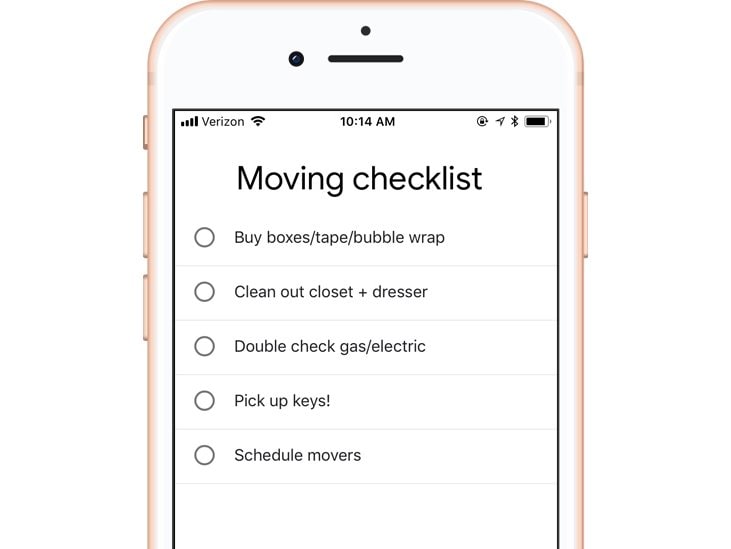

There are three things we like about Things 3: Its clean user interface, several calendar integrations, and it sounds like a trilogy of classic monster movies—Anyone see Things 1 and 2? ?♀️
But even our favorite things have their flaws, and Things 3 is no exception. Accessibility, pricing, overall functionality, and lack of collaboration features leave a lot to be desired when it comes to Things 3.
So what do you do?
You seek out an alternative that can fill every feature gap—and then some. And we’re here to help!
With all the productivity apps out there, looking elsewhere can be overwhelming. We’ll help you sort through your options with this shortlist of the nine best Things 3 alternatives.
What Should You Look for in a Things 3 Alternative?
Things 3 is only available within the Apple ecosystem, which means you’ll need a Mac, iPhone, or iPad to use it. And since there’s no web-based app, you can only access your to-do lists from your devices—not from any device with internet access.

While there’s no ongoing subscription fee for Things 3, there’s also no free version of this app. Plus, you’ll have to pay a separate fee for each of your iOS devices ($49.99 to add it to your Mac, $19.99 to add it to your iPad, and $9.99 to add it to your iPhone or Apple Watch, for a grand total of $80).
There are also no collaboration features, so this app works better for individuals than teams. Even individuals trying to plan a beach vacation with their besties may need to look elsewhere to get everyone on the same page. ?️
When we’re looking for the best alternative to Things 3, we want an app that has similar strengths but with fewer drawbacks. Here’s our checklist of functions and features that every good to-do list app should offer:
- User-friendly design
- To-do-list templates for a quick setup
- A web app
- Collaboration features
- Free or affordable plans
The 10 Best Things 3 Alternatives to Use
These are a few of our favorite Things 3 alternatives. While none of them come in brown paper packages tied up with strings, these nine apps offer a strong combination of the features listed above and include options for iOS, Android, and Microsoft users.
1. ClickUp
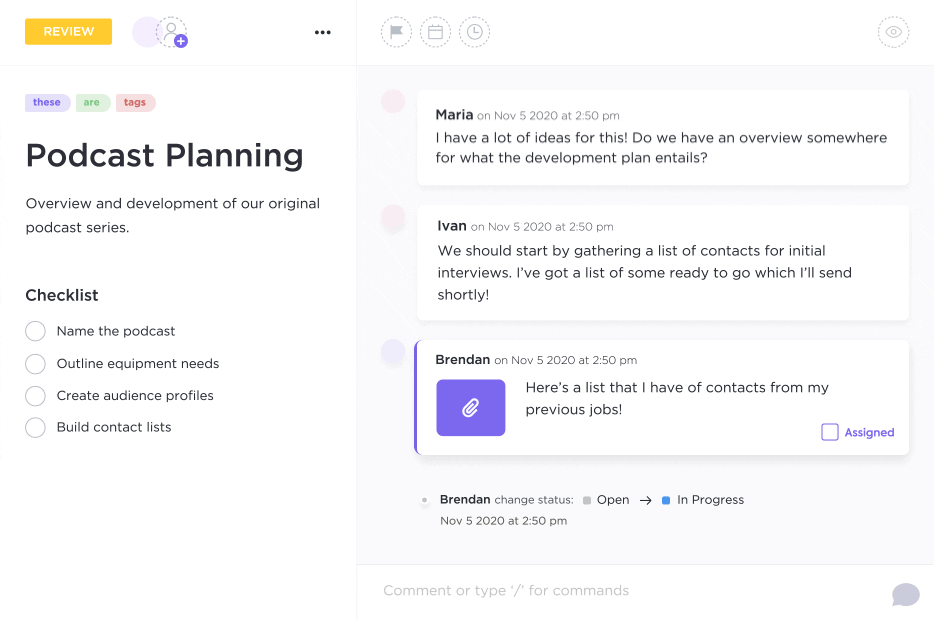
ClickUp isn’t just a task management tool, it’s an entire toolbox. ?️
While to-do list apps are built for individuals and project management tools are built for teams, ClickUp is built for both. Its powerful features scale to accommodate projects of all sizes. So whether you’re trying to organize an apartment hunt or a product launch, ClickUp can help you get it done.
This platform features creative spaces, like ClickUp Whiteboards and Docs, where you can brainstorm your ideas, and project boards where you can create nested Task Checklists and assign them to other members.
With an intuitive user interface that includes drag-and-drop functionality and hundreds of dynamic task management features like Tags, Checklists, and Custom Fields, you can organize your workflow your way. And with ClickUp’s desktop, web-based, and mobile apps for iPhone or Android, you’ll have access to your work anywhere you go.
Best features
- ClickUp’s Template Library with over 1,000 pre-built resources for any use case including the Task Management Template and the Getting Things Done Template to set up your task List quickly
- ClickUp Docs are ideal for brainstorming and organizing your ClickUp Tasks. If you use the Getting Things Done (GTD) method of task management, Docs will help you stay organized during the idea capture phase
- Collaboration features allow you to assign tasks and due dates to other people. You can also leave comments, chat, and edit docs alongside each other
- Built-in time tracking helps you visualize how long different tasks take and make more informed decisions about due dates in the future
- Integrations make it easy to connect your ClickUp task list to your Apple, Outlook, or Google Calendar app
Limitations
- Because ClickUp has so many customizable features, there can be a learning curve for first-time users
- Not all of ClickUp’s features are available on the free plan
Pricing
- Free Forever
- Unlimited: $7 per user per month
- Business: $12 per user per month
- Enterprise: Custom pricing
Ratings and reviews
- G2: 4.7/5 (8,350+ reviews)
- Capterra: 4.7/5 (3,720+ reviews)
2. Workflowy

Workflowy’s motto is, “a simpler way to organize your work.” Simplicity is by far Workflowy’s biggest strength.
This task management app allows you to create nested bulleted lists, so you can organize your parent tasks into one list and then break each bullet point down into subtasks by adding a nested list under your main task.
You can keep breaking down bullets into further nests, so you can add subtasks, sub-subtasks, sub-sub-subtasks, and so on.
Workflowy is available as a web app, a desktop app for Windows, MacOS, and Linux, and a mobile app for iOS or Android.
Best features
- The simple design makes this app incredibly easy to use with no learning curve or startup time
- Intuitive collaboration features allow you to invite anyone to your list by sharing a link, and you can give viewing-only or editor permissions to each of your collaborators
Limitations
- Workflowy has limited formatting options, which can make it more difficult to differentiate between your tasks at a glance
- The user interface isn’t point-and-click like many of the other apps on this list, and you may need to learn a variety of keyboard shortcuts to use this platform effectively
Pricing
- Basic: Free
- Pro: $4.99 per month
Ratings and reviews
- G2: 4.4/5 (20+ reviews)
- Capterra: 4.6/5 (10+ reviews)
3. Google Tasks
If you’re already ingrained in Google Workspace, then Google Tasks could be an easy fit for your existing workflow.
While users used to complain that Google Tasks lacked some of the key features that other to-do lists offered (like syncing with your calendar app), recent updates have included big improvements. So, this app really embodies the “If at first you don’t succeed …” mantra. ?
Now, any tasks you get through Gmail, appointments you add to Google Calendar, or reminders you set through Google Assistant are added to the Tasks app in real-time. So, you can stop ping-ponging between apps. ?
Now when you consult Google Tasks, you’ll see all your daily tasks in one place. Because it’s made by Google, it’s a great app for Android users, but they also offer apps for iOS and desktop.
Best features
- If you’re already in the Google ecosystem, real-time syncing with other Google apps makes it easy to organize all of your tasks in one place
- Sharing features that are similar to sharing in Google Docs allows you to invite others to view or edit your lists
- Kanban boards allow you to track the progress of your to-dos or organize your to-do lists by themes
Limitations
- Google Tasks is definitely a to-do list app and not a project management tool. There are no project management calendars, and its features aren’t advanced enough to organize complex projects
- If you use more than one Google account, like separate work and personal accounts, you won’t be able to see all of your to-dos in one place. You’ll have to check each Google account’s associated Tasks account separately
Pricing
- Free
Ratings and reviews
- G2: No reviews available
- Capterra: No reviews available
4. 2Do

2Do is a feature-rich to-do list app with a user interface that even designers admire.
Even with the ability to sort, filter, tag, add locations, set date ranges, and batch edit, one of the most impressive things about 2Do is it fits so many functions into such a clean layout. ?
You can use this app to set up a simple to-do list or similar Things 3, you can use it to implement a Getting Things Done (GTD) productivity plan where you capture your ideas and prioritize your work.
2Do markets itself as a personal task manager, and it’s definitely built for individual productivity, not team productivity. This app is for the lone wolves of this world. ?
It’s also best for Mac users. This platform started out as a to-do list app for Mac and iOS devices only, but it’s now available as an Android app as well. The desktop version is still only available on MacOS.
Best features
- Location-based notifications will remind you of tasks, like “buy groceries” or “pick up the dry cleaning,” whenever they’re nearby and easy to complete
- Advanced scheduling features make it easy to set up recurring tasks at any frequency you want
- Advanced search means you can plan multiple projects and hundreds of tasks simultaneously, without losing track of a single one
Limitations
- The pricing model for 2Do is very similar to the pricing model for Things 3, meaning there’s no free version. You’ll pay a one-time fee and have access to install the program on up to five devices
- There are no collaboration features, so you can’t invite others to edit your lists or assign tasks
Pricing
- Single-User License: $49.99
- Multi-User License: $149.99
Ratings and reviews
- G2: 3.5/5 (2+ reviews)
- Capterra: No reviews available
5. Gone
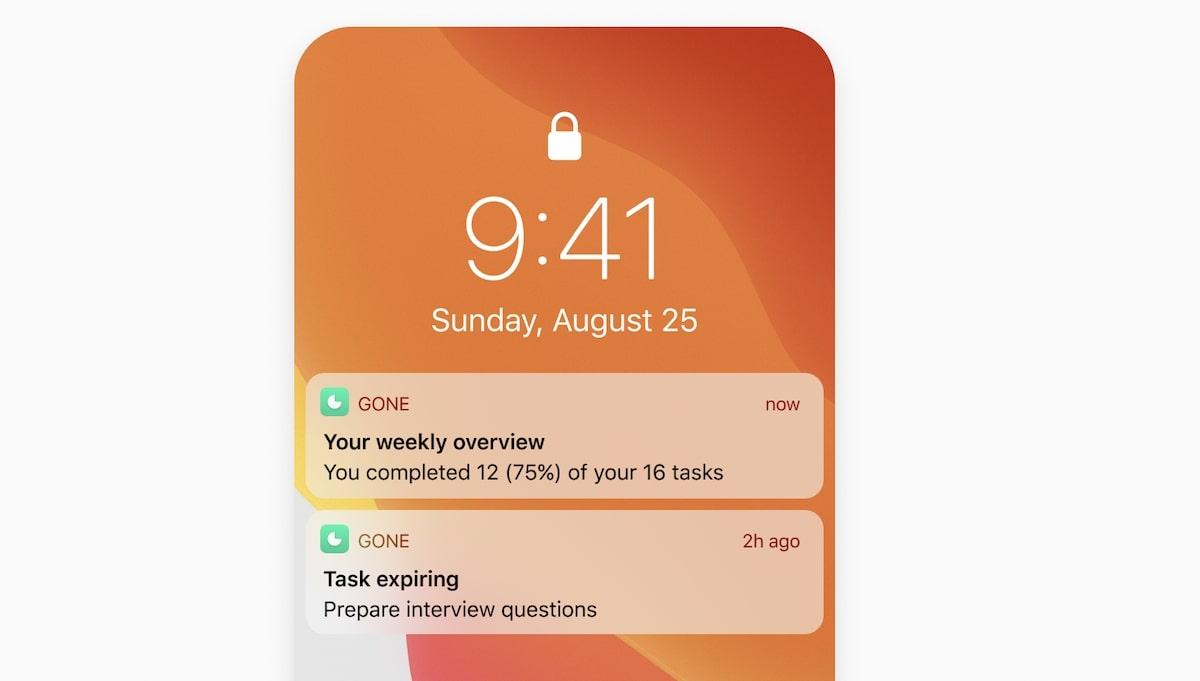
If gamification is the only way you can convince yourself to do anything, we get it. We all need a little extra motivation sometimes. The Gone app provides that motivation by acting like your countdown timer in a productivity game. ⏱️
Once you add a to-do item, it’s only available in your list for 24 hours before it disappears. Complete all your tasks to win the day.
You’ll get notifications when tasks are about to disappear so you can tackle them in the nick of time. And at the end of the week, you’ll get a score that shows what percentage of your tasks you completed within 24 hours. This system can give you a better idea of how much you can accomplish in a day and help you develop stronger workload management skills as you go.
Best features
- The gamification element of this app can motivate you to complete more tasks
- The simple checklist design is easy to use with no learning curve
- The 24-hour timeline helps you concentrate on your daily tasks and avoid overextending yourself
Limitations
- Gone is only available as a mobile app for iOS devices. It’s not available for desktop or for Android, and you’ll only be able to access it from your iPhone or iPad—not from any device with the internet
- Disappearing tasks could lead some of your to-do list items to fall through the cracks or make it so you have to re-enter items multiple times before you get them done
Pricing
- Free
Ratings and reviews
- G2: No reviews available
- Capterra: No reviews available
6. Akiflow
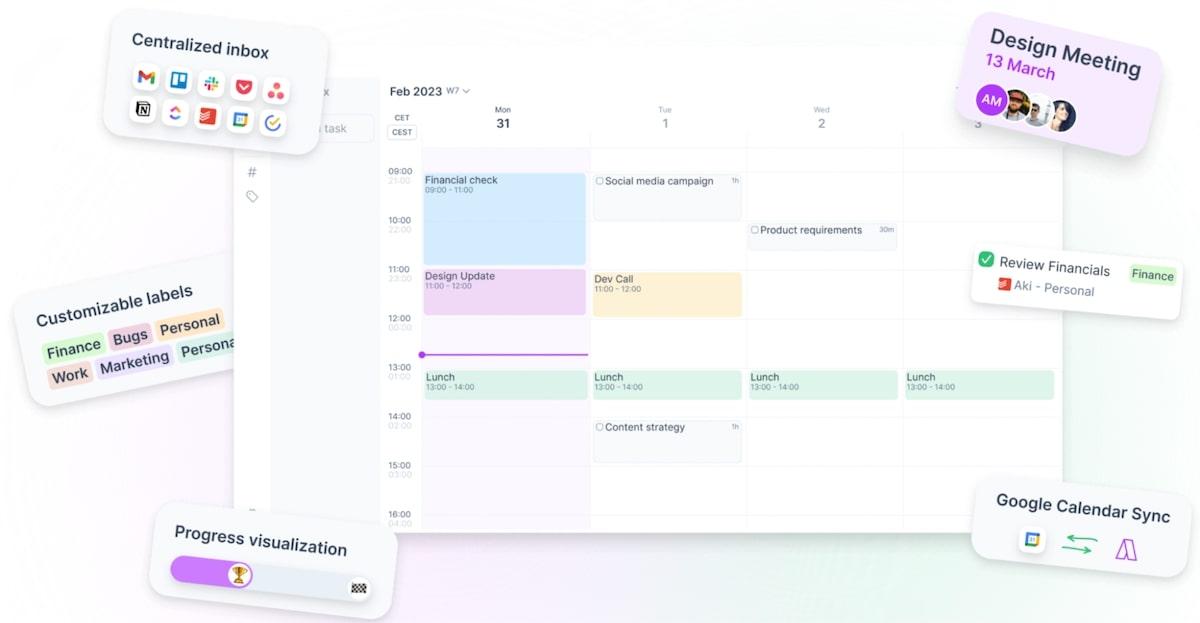
This app is for the supertaskers out there. ?
As much a task-scheduling software as it is a task list, Akiflow helps you keep track of your to-dos and your calendar at the same time. It also integrates with other project management tools—like ClickUp, Asana, Trello, Jira, and Todoist—so you can import your tasks from multiple platforms and use Akiflow to organize, prioritize, and schedule each task.
This app is a great choice for users who want an extremely detailed breakdown of their days. It’s available as a web app or as a desktop app for Mac or Windows. Mobile apps for iOS and Android are currently in beta testing.
Best features
- Time blocking allows you to drag-and-drop items from your to-do list to your calendar to instantly schedule each task
- The inbox and calendar feature simplifies the process of collecting and scheduling your tasks by showing your to-do list and calendar side-by-side
- Integrations allow you to import tasks from your most-used apps, like Slack, Gmail, Notion, and ClickUp, so you can spend less time compiling your to-dos
Limitations
- While there is a seven-day free trial, there’s no free plan, and the monthly rates are high compared to other to-do-list apps
- Many users find the features work better for task management than project management, so you may need a different tool if you’re planning complex team projects
Pricing
- Monthly Plan: $24.99 per month
- Yearly Plan: $14.99 per month
Ratings and reviews
- G2: 5/5 (30+ reviews)
- Capterra: 4.8/5 (50+ reviews)
Check out our list of close alternatives to Akiflow
7. Microsoft To Do
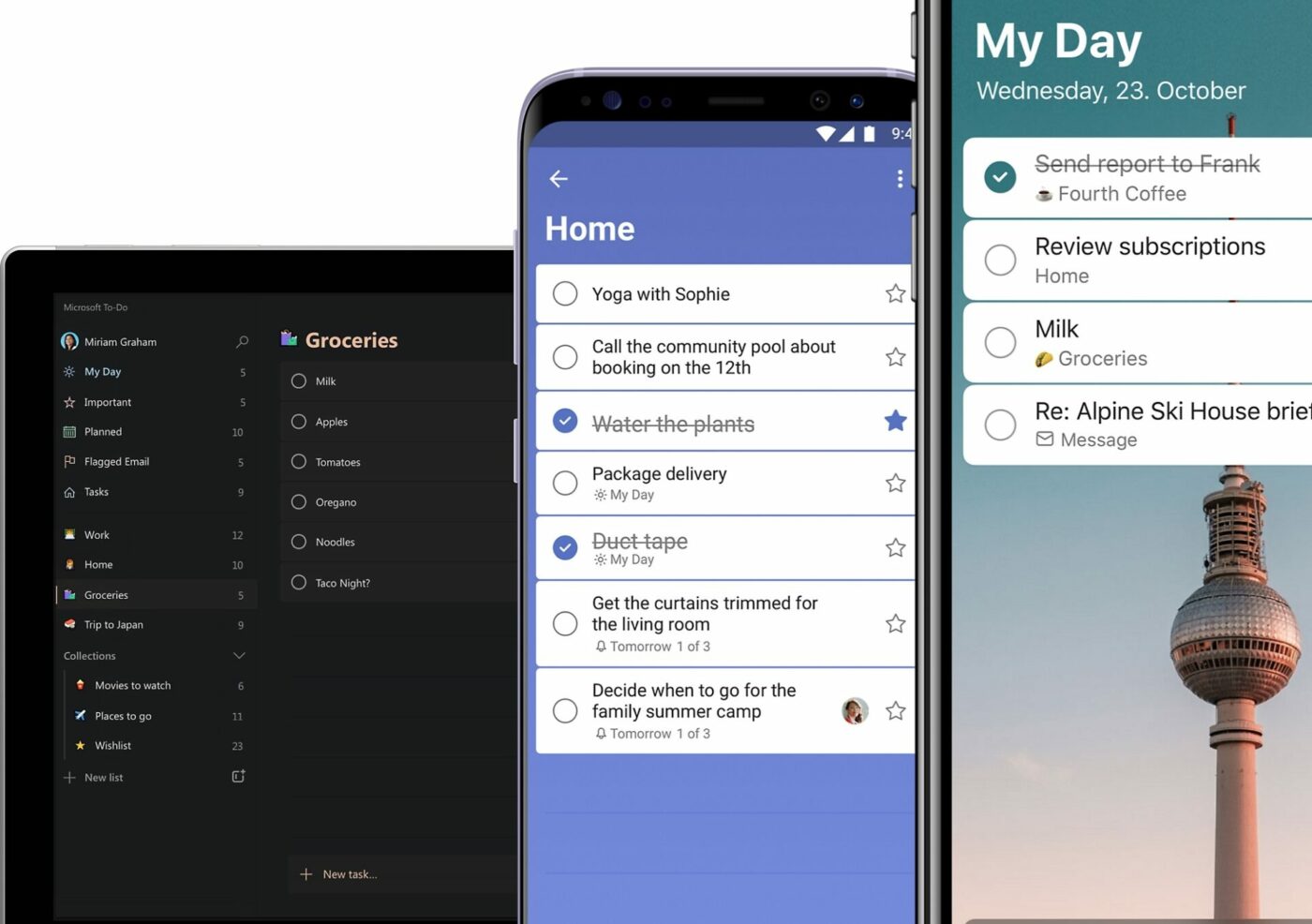
In 2015, Microsoft bought Wunderlist, one of the most popular to-do list apps at the time. They took the key features of Wunderlist, integrated them into Microsoft To Do, and discontinued the first app in favor of To Do, which integrates into the Microsoft 365 ecosystem.
So if everything you do runs through that ecosystem, then Microsoft To Do will fit symbiotically into your workflow.
This program plays nicely with Microsoft Planner and Outlook, and will automatically add tasks assigned in Planner or flagged emails in Outlook to your to-do list. And while this app may make the most sense for 365 users, it’s also available for iOS or Android.
Best features
- The layout of this app looks a lot like a daily planner, so you’ll be able to visualize your day and your week ahead in a familiar format
- It’s easy to schedule recurring tasks, even on a custom schedule
- You can collaborate on tasks by assigning items to other people from directly within To Do or from within Microsoft Planner
Limitations
- While To Do has some options for customizing the visual layout of the app, the options are limited and many users complain that there aren’t enough advanced formatting features
- There’s no built-in calendar view, so you can only see your tasks in list format
Pricing
- Free
Ratings and reviews
- G2: 4.4/5 (60+ reviews)
- Capterra: 4.6/5 (2,750+ reviews)
8. Taskade

Taskade straddles the line between a personal task management app and a team project management app—with features that fall somewhere between the two. ?♂️
It’s a good choice for individual super users or for small teams. But big teams might find that the features aren’t quite robust enough.
If you’re someone who mostly consults your task list from your mobile device, then you’ll love Taskade’s native app design. It runs quickly and has options for widgets that can help you visualize your to-dos and project progress.
The mobile app is available for iOS or Android. There are also desktop apps for Mac, Windows, and Linux, and browser extensions for Chrome, Firefox, and Edge.
Best features
- Taskade makes it easy to manage both your professional and personal to-dos in one app with separate areas for each part of your life
- The collaboration features include not only the ability to assign tasks to teammates but also an in-app video call feature that allows you to have a face-to-face chat
- It has strong note-taking features for brainstorming and documentation, or for the capture phase of your Getting Things Done process
- Outlining capabilities to manage tasks
Limitations
- Taskade only offers a few integrations, so you’ll have to add most of your tasks manually, rather than having them automatically imported
- Many users state that they would like to see more customization options and say that the interface can feel cluttered
Pricing
- Free
- Starter: $4 per month
- Plus: $8 per month
- Pro: $19 per month
- Business: $49 per month
- Ultimate: $99 per month
Ratings and reviews
- G2: 4.7/5 (25+ reviews)
- Capterra: 4.7/5 (45+ reviews)
9. Todoist

For a task management app that’s simple, clean, and organized, Todoist is an easy-to-use option.
You can create a basic daily checklist, or you can add multiple projects and create separate checklists for each. There are simple sharing features. And you can invite other people to your projects and delegate your tasks to family members or team members.
This app works with a variety of personal productivity strategies, including GTD and the Pomodoro technique. While you can also use it to organize simple team projects, it’s a better task management tool than a project management tool.
Todoist is available as a desktop app for Mac, Windows, or Linux, a mobile app for iOS or Android, and a browser extension for Chrome, Firefox, Edge, and Safari.
Best features
- Natural language prompts allow you to create a new task or a custom recurring schedule simply by typing what’s in your head
- The Projects feature allows you to create separate to-do lists for your work life, personal life, and other categories
- The Karma feature allows you to track your productivity visually with graphs and charts that show your task completion rate
Limitations
- Reminders aren’t available with the free plan
- Limited integrations make it difficult to connect to your email, calendar, or note-taking apps
Pricing
- Beginner/Starter Plan: Free
- Pro Plan: $4 per month
- Business Plan: $6 per member per month
Ratings and reviews
- G2: 4.4/5 (760+ reviews)
- Capterra: 4.6/5 (2,250+ reviews)
10. TickTick
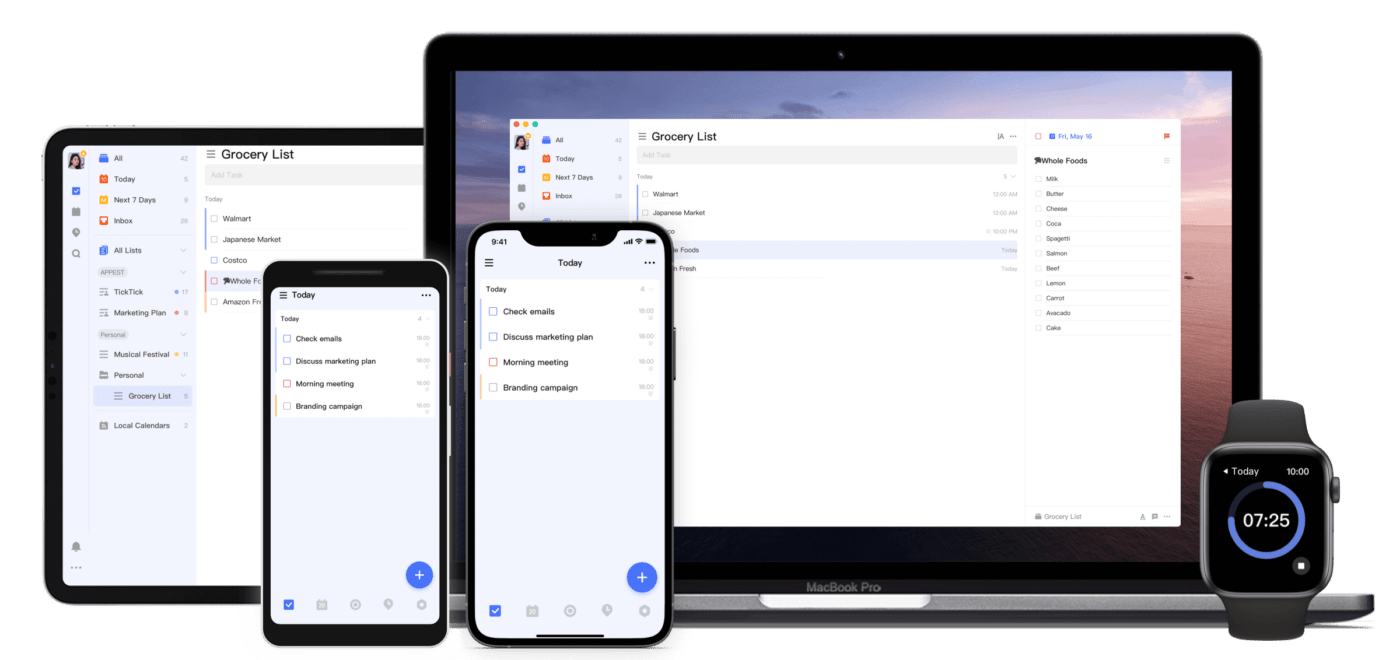
TickTick is a popular task management app that helps individuals and teams stay organized and productive. With TickTick, users can create to-do lists, set reminders, schedule tasks, and collaborate with others.
Compare TickTick Vs Todoist!
Best features
- Built-in Pomodoro timer
- Reminders for schedules along with location-based alerts
- Available for iOS (iPhone & iPad)and Android
Limitations
- No native calendar sync
- Limited integration options
- The free version is limited to only 99 tasks (we wish it was at least a round number ?)
Pricing
- Basic Plan can be upgraded to Premium Plan at $27.99 per year
Ratings and reviews
- Capterra: 4.8/5 (80+ reviews)
- G2: 4.5/5 (80+ reviews)
Check out these TickTick alternatives!
Find the Right Thing to Replace Things 3
They say the best things in life are free, and you can start using ClickUp—one of the best Things 3 alternatives—for free right now.
With ClickUp, you have the power to organize your Workspace your way. You can create separate task lists for your work life and personal life, and you can organize to-dos to meet any long-term goals.
Plus, more than 1,000 customizable templates to walk you through the tasks associated with life’s major moments. So whether you’re closing on your first house, planning your wedding, or organizing a content calendar for your blog, ClickUp will help you figure out everything you need to do and get it done.
It’s the perfect app for planning the little things, the big things, and all the things in between. Try ClickUp for free today.




